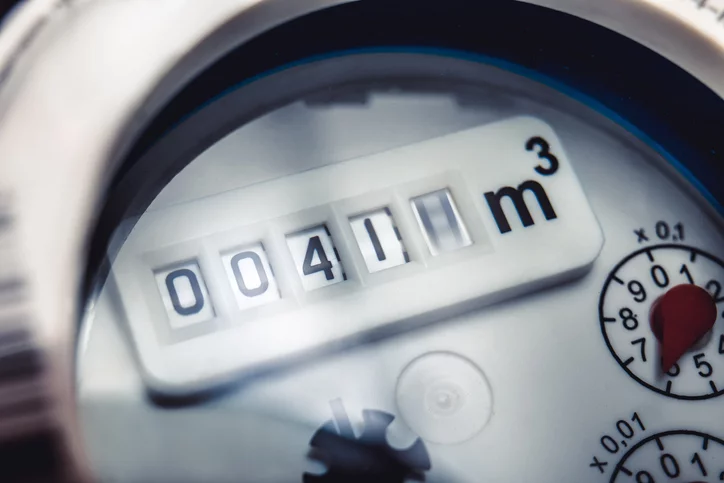The Water Mark 2025: Methodology
Customer perception data (Water Matters)
Five metrics were considered as a whole dataset with 95 data points (19 x 5) for Water and Sewerage companies (WaSC’s) and Water only Companies (WoC’s) colour code ranking. These are ‘net satisfaction with overall service’, ‘net satisfaction with value for money’, ‘charges (bills) are fair’, ‘affordability’ and ‘awareness of additional services’.
The five-year rolling average data for these metrics was then used to calculate quartile boundaries as below:
- Minimum value: 43.81%
- First quartile boundary: 57.38%
- Second quartile boundary: 71.87%
- Third quartile boundary: 77.63%
- Maximum value: 88.52%
These calculations gave an indication of good and poor performance across all of the metrics and helped us to determine the long term ambitions that we want to see within the water sector. To simplify this, we have then used the 85%, 70%, 50% percentile boundaries to colour code performance as shown below. These percentages fall close to the quartile boundaries which we calculated above.
| Perceptions data range | Colour ranking |
|---|---|
| Above 85% | Good |
| Above 70% to 85% | Moderate |
| Above 50% to 70% | Weak |
| 50% and below | Poor |
Notes:
- Net satisfaction with value for money, is based on merged Q9 and 10 data for WaSC’s and Q9 only for WoC’s
Total complaints
For the purpose of colour coding the written complaints per 10,000 connections data, this included 11 data points for WaSC’s and 8 data points for WoC’s. These have been used to calculate quartile boundaries for WaSC’s and WoC’s separately and these were then used to colour code the written complaints data as below.
| Total complaints per 10,000 connections | Colour ranking |
|---|---|
| Below Q1 value | Good |
| Q1 value and below Q2 value (median*) | Moderate |
| Q2 value (median*) and below Q3 value | Weak |
| Q3 value and above | Poor |
*Median – a mid-point of the data set, or a middle value in the list of numbers that are arranged by highest to lowest.
Complaints handling measure
The complaints handling measure is a composite of the percentage of escalated Stage 2 Total complaints (compared to total complaints) received by companies and complaints made about companies to CCW per 10,000 connections. Both components are based on the quartile performance within WaSC and WOC bandings where Quartile 1 is the best performing quartile. Each quartile is then scored as follows.
- Quartile 1: 1
- Quartile 2: 2
- Quartile 3: 3
- Quartile 4: 4
The respective scores for Stage 2 total complaints and Complaints made about companies to CCW each company are then added together to determine their respective complaint handling score. Each company is then assigned an overall complaint handling ranking in accordance with the following criteria:
| Complaints handling measure – score | Colour ranking |
|---|---|
| 2 | Good |
| 3 – 4 | Moderate |
| 5 – 6 | Weak |
| 7 – 8 | Poor |
For both total complaints and the complaint handling measure, Where we compare the performance of individual companies we do so within their respective segments as either Water and Sewerage Companies (WaSCs) or Water Only Companies (WOCs).
Operational data
For the purpose of colour coding operational data, each of the metrics included 19 companies data points (only 11 WaSC companies for flooding data). These have been used to calculate quartile boundaries for each metric and these were then used to colour code operational performance as below. (For the metrics used, lower values would indicate better performance).
| Operational Data range |
Colour ranking |
|---|---|
| Below Q1 value | Good |
| Q1 value and below Q2 value (median*) | Moderate |
| Q2 value (median*) and below Q3 value | Weak |
| Q3 value and above | Poor |
*Median – a mid-point of the data set, or a middle value in the list of numbers that are arranged by highest to lowest.
To allow us to compare companies of different sizes and make comparisons customer friendly, we have taken the following steps:
- Flooding data – The total number of incidents has been normalised based on ‘Flooding incidents per 10,000 sewerage connections.’
- Supply interruptions data: this is already in a normalised per property basis.
- Leakage data[2]: The total company leakage in Ml/d has been normalised based on ‘Leakage per property served’. The total number of water connections has been used for this. Leakage data can be normalised by ‘cubic meters per km main per day’ or ‘per property per day’, the latter has been used as this is more relatable for water customers.
- Average Annual PCC: this is already normalised on litres per person, per day basis.
Notes:
There may be slight variation with normalised data with what has been submitted to Ofwat as CCW have used year end connections data rather than an average count.
[2] Leakage comparisons for Actual versus target and cubic meters per km main per day can be found at https://discoverwater.co.uk/leaking-pipes
Environment Performance Assessment (EPA) data
The table shows how EPA star ratings have been ranked for the Water Mark. This data has been taken from the Environment agency and Natural Resources Wales.
Natural Resources Wales assess Dŵr Cymru’s performance against the seven metrics in the Environmental Performance Assessment (EPA). The EPA is standardised across England and Wales. This allows the performance of the ten largest water and sewerage companies to be monitored and assessed in a consistent way by the environmental regulators.
Hafren Dyfrdwy is a much smaller company than Dŵr Cymru, and therefore Natural resource Wales do not apply the EPA methodology to their annual assessment. Instead they report performance across similar themes, for example pollution incidents and permit compliance.
| EPA score | Colour ranking |
|---|---|
| Four stars | Good |
| Three stars | Moderate |
| Two stars | Weak |
| One star | Poor |



